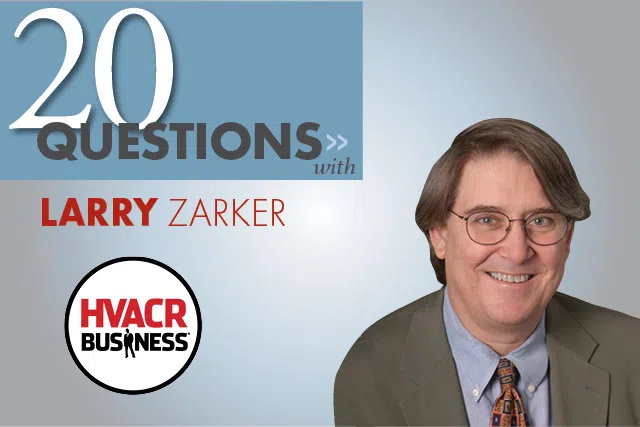HVACR Business Editor Pete Grasso recently met with Larry Zarker, chief executive officer of the Building Performance Institute (BPI) in Malta, N.Y.. Zarker discusses selling comfort instead of equipment, the benefits of home performance contracting and why it makes sense for HVACR contractors.
1. What's your background?
I grew up in a home building/remodeling family. I went through graduate school in kind of a technology assessment, looking at innovation and potential impact of innovation and downside risk and unintended consequences. From there I went to work at the National Association of Home Builders (NAHB) Research Center.
2. How did you get started at BPI?
I moved over to BPI after 20 years at NAHB, and I've been here about 10 years now. We are primarily focused on existing homes but for me it was a natural transition.
3. What is BPI's mission?
We set standards on how to analyze and upgrade the performance of homes and then we certify the workforce. A building analyst is the individual who has the knowledge, skills and abilities to evaluate the home and do diagnostic testing, set a prioritized work scope for what needs to be done to upgrade the performance.
4. What is home performance?
Home performance is a systematic evaluation of the condition of a home, from the perspective of how well it delivers comfort, energy efficiency, durability, as well as, health and safety for the occupants. And from that evaluation, which includes qualitative observation and quantitative diagnostic testing, you can establish where the problems are and create a prioritized roadmap of what needs to be corrected. It's not just energy efficiency, but also comfort, health, safety and durability.
5. Can you give an example?
If you find that you have a crawlspace underneath part of the living area and that crawlspace isn't insulated or vented, and you have HVAC equipment and ducting running through that crawlspace to deliver comfort into the room above, the chances are it's compromised. It makes a lot of sense to deal with the crawlspace, air sealing, insulation to provide an opportunity for that ductwork to deliver the comfort.
6. What's the biggest trend right now in home performance?
We're not selling products. The people who are certified are actually looking for the problem areas and where do you get the biggest bang for the buck to improve the overall comfort of the occupants.
7. How does indoor air quality (IAQ) fit into the mix?
IAQ has to be larger than just the equipment. Are you just trying to sell a piece of equipment that attaches on the HVAC system to capture, through some kind of filtering process, potential pollutants? Or are you looking at the source of where these pollutants come from?
8. How is home performance different than energy audits?
A traditional energy audit looks for ways to, essentially, reduce consumption of electricity and natural gas or oil. And so it might look for ways to change out the equipment. But when you move to home performance, you're looking at the entire envelope and how air gets into the house.
9. What's the first thing an HVACR contractor should know about getting into home performance?
Our Building Analyst certification is a great introduction to how you measure the tightness of a home. It helps you optimize the envelope of the home. HVACR contractors understand the heating and AC side of the equation, but sometimes they don't understand all the other things.
10. How much training is involved?
We have a national network of test centers who do the training and Building Analyst certification tends to be five- to six-day course. That's partially classroom and partially learning how to use the diagnostic equipment.
11. Are there any resources to help implement this into an existing HVACR business plan?
We have a program for contractors called the GoldStar Contractor where we help them recognize the standards and get their workforce certified. We also help them succeed as a business.
12. Why should the HVACR contractor consider getting into home performance?
You're already building a relationship with the customer that's going to last years. If you help them identify how their house is working or not working and create that roadmap for what they need to do, they'll have confidence that you know what you're doing and will deliver for them.
13. Is it more profitable for the contractor?
Yes. You're crazy busy in the summer and crazy busy in the winter and then you've got these swing seasons that are difficult for keeping the staff occupied. If you embrace home performance, you find that you're able to do a consistent level of work all year. You have higher margins on average and you're shifting the mix up to higher efficiency equipment.
14. What is the typical initial investment for an HVACR contractor to get into home performance?
At the base level, you're probably looking at $10 to $12,000. And what that means is that you're paying your people to go to training.
15. What's the main selling point to the customer?
The drivers have to do with comfort. It has to do with getting Jenny back out on the soccer field, not having to use the inhaler all the time.
16. Do homeowners understand home performance?
The things that really matter to them about the home is their castle. Energy efficiency may be some critical to the regulator, but it's really hard to sell savings.
17. Is there a need to educate homeowners on home performance?
You have to sit around the table and find out what's driving them. What kinds of issues are they having with they're home? Are there rooms where you can't control the temperature? Do you have musty smells? If you're responsive to what their real concerns are, you can probably find a way to do the testing to help identify what's causing those problems. So comfort is a huge driver.
18. What kind of manufacturer/supplier support is there for the HVACR contractor who also does home performance?
I've spoken at some of the distributor meetings with top contractors and I find that's a very good environment for the manufacturer who wants to give the contractor the opportunity to look at home performance and see if it fits their model. It's a comfortable setting for the contractor to know the distributor wants them to have these ideas put in front of them in an educational forum.
19. Why has there been reluctance by HVACR contractors to embrace this?
The reality is, if your company's business model requires that all you do is change out equipment, you can't just say now you're going to go do home performance and you're going to spend a half-day evaluating the home and making recommendations. It could really affect your cash flow. Home performance requires a completely different mindset and it's difficult for businesses to make that transition.
20. What kind of ROI can an HVACR contractor expect when adding home performance?
When you do HVAC plus home performance contracting, the average ticket size increases. And numbers we've seen are anywhere from $5,500 to $7,500 on HVAC to $8 to $15,000 for a home performance job. That gross margins were 38 to 45 percent on HVAC and HVAC plus home performance are 45 to 50 percent. And then there's a question about close rates, which are typically better because you're instilling confidence that you're actually solving problems.






